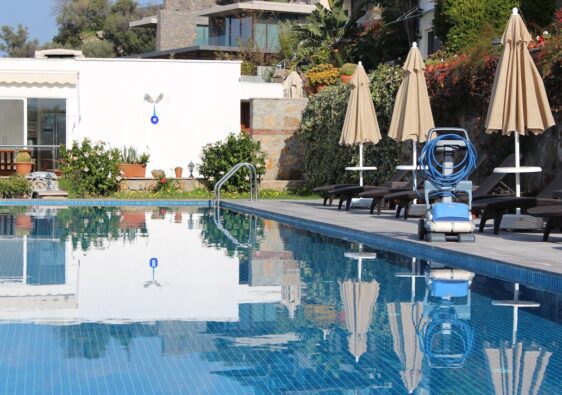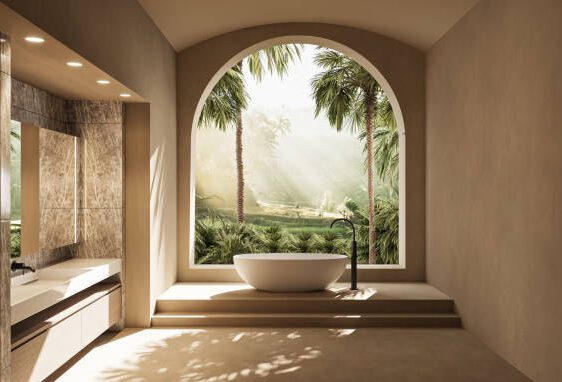Picture yourself diving into the crystal-clear waters of an indoor swimming pool, surrounded by pristine walls and a flawless finish. Now imagine the disappointment of realizing that the paint on those walls is peeling, cracking, or fading away.
Don’t let poor paint choices ruin your aquatic oasis! Choosing and applying the right paint in indoor swimming pools is crucial for both aesthetic and practical reasons.
In this article, we will explore the best practices for selecting and applying paint in indoor swimming pools, covering everything from paint types to application techniques.
So, let’s dive in and make a splash with a flawless finish!
Choosing the Right Paint for Indoor Swimming Pools
Swimming pools are the perfect place to relax, unwind, and keep fit all year round. However, when it comes to indoor pools, choosing the right type of paint can make a big difference in terms of durability, appearance, and maintenance.
- Epoxy Paint. This is a popular choice for indoor swimming pools due to its durability and resistance to chemicals and water. It creates a hard, glossy surface that is easy to clean and maintain, but it can be difficult to apply and requires careful preparation.
- Chlorinated Rubber Paint. This is another option for indoor swimming pools, particularly those that are exposed to high levels of chlorine or other pool chemicals. It is easy to apply, dries quickly, and provides a non-slip surface.
- Acrylic Paint. This paint is a budget-friendly option for indoor swimming pools that are not heavily used. It dries quickly, is easy to apply, and is available in a range of colors. However, it may not be as resistant to chemicals and water as epoxy or chlorinated rubber paints.
Factors to Consider when Choosing
When selecting the right type of paint for your indoor swimming pool, there are several factors to consider. These include:
- Durability. When it comes to durability, you’ll want to think about how long you want your paint job to last. Are you willing to repaint your pool every few years, or do you want a longer-lasting option?
- Ease of Application. Applying paint to an indoor pool can be a tricky process. Do you feel confident enough to tackle the job yourself, or will you need to hire a paint professional?
- Resistance to Pool Chemicals. Your pool is likely to be exposed to a range of chemicals, including chlorine and other pool chemicals. You’ll want to choose a paint that is resistant to these chemicals to protect your paint job and ensure it lasts as long as possible.
- Cost. Painting your pool can be an expensive process, so it’s important to keep your budget in mind. Make sure to consider the cost of the paint and any additional materials or professional help you may need.
- Appearance. Last but not least, you’ll want to consider the appearance of your pool. What color and finish do you want, and how important is the appearance to you? Some types of paint offer a wider range of color options than others.
Applying Paint in Indoor Swimming Pools
The process of painting an indoor swimming pool typically involves two main steps: priming and painting.
The primer serves as a base layer for the paint and helps it adhere to the pool’s surface. Once the primer has dried, it’s time to apply the paint. Most types of pool paint require two coats for proper coverage, so plan accordingly.
Now that you’ve got your paint and primer ready, it’s time to tackle the actual painting process. But before you start slapping on that paint like a wild pirate, here are some best practices to keep in mind.
1. Gather Your Tools and Equipment
The right tools and equipment are essential for a successful painting project. Make sure you have everything you need before you begin, including a high-quality paint roller, brush, and extension pole. A paint sprayer can also be helpful, but it’s not always necessary.
2. Work in Small Sections
To ensure proper coverage and avoid drips and runs, it’s best to work in small sections. This will allow you to focus on one area at a time and ensure that each section is covered evenly. It’s also a good idea to overlap each section slightly to ensure that there are no gaps or missed spots.
3. Apply the Paint Evenly
Applying the paint evenly is key to achieving a professional-looking finish. Make sure to use a steady hand and apply the paint in smooth, even strokes. If you’re using a roller, use a light touch and avoid pressing too hard, as this can create bubbles and lead to an uneven finish.
4. Use the Right Technique
Different types of paint require different application techniques. For example, some paints require a crosshatch or crisscross pattern, while others require a W or M pattern. Follow the manufacturer’s instructions carefully to ensure that you’re using the right technique for your paint.
5. Clean Up Properly
After you’ve finished painting, it’s important to clean up properly. Use a high-quality paint thinner to clean your tools and equipment, and dispose of any leftover paint properly. It’s also a good idea to ventilate the area well and allow the paint to dry completely before using your pool.
Maintenance and Care of Painted Surfaces in Indoor Swimming Pools
Regular maintenance is essential to ensure the longevity of painted surfaces in indoor swimming pools. This includes regularly cleaning your pool and its surrounding surfaces to prevent the buildup of dirt, grime, and other debris.
To keep your painted surfaces looking their best, it’s important to use the right cleaning techniques. Use a soft-bristled brush or sponge and a mild, non-abrasive cleaner to remove any dirt or stains. Avoid using harsh chemicals or abrasive scrubbers, as these can damage the paint and create scratches or other imperfections.
If you encounter stubborn stains on your painted surfaces, don’t worry! There are a few tricks you can try to remove them. For example, baking soda and vinegar can be used to remove mildew stains, while a solution of water and muriatic acid can be used to remove mineral stains.
Likewise, regular inspections and touch-ups are crucial to prevent damage and ensure a safe swimming environment. This is especially important for pool inspectors who must ensure that the painted surfaces are up to code and free of any defects or hazards.
Touch-ups should be done as soon as any signs of wear and tear are spotted, to prevent further damage and extend the life of the paint.
Closing Thoughts
Don’t let a drab pool bring you down – with the right paint and application techniques, you can turn your indoor swimming pool into a stunning oasis. And don’t forget to regularly maintain and care for your painted surfaces, so you can continue to enjoy a beautiful and safe swimming environment.



